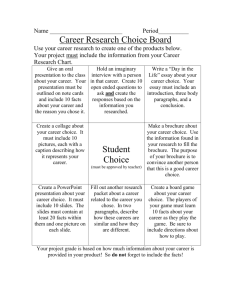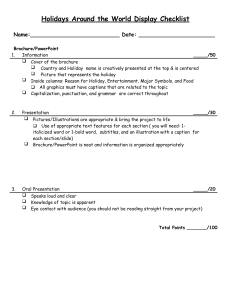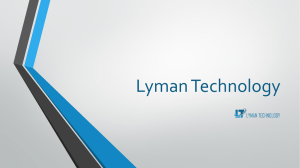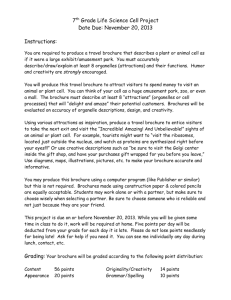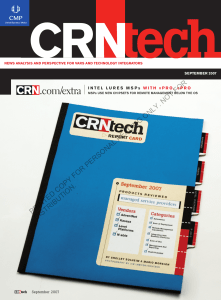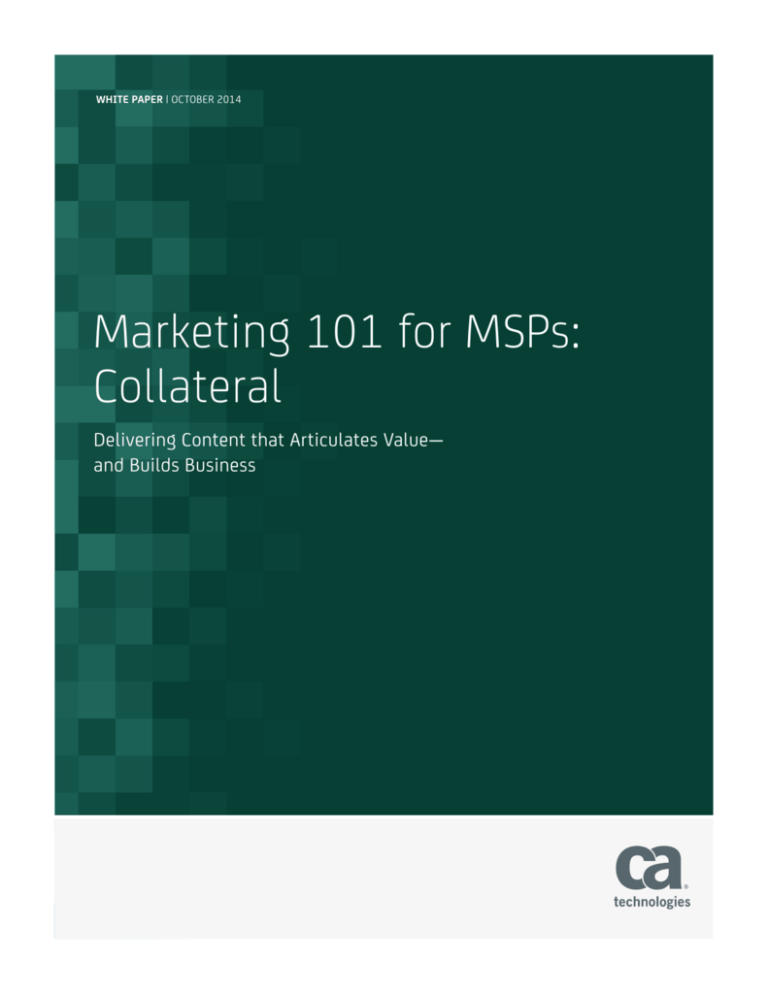
WHITE PAPER | OCTOBER 2014
Marketing 101 for MSPs:
Collateral
Delivering Content that Articulates Value—
and Builds Business
2 | WHITE PAPER: MARKETING 101 FOR MSPS: COLLATERAL
ca.com
Table of Contents
Introduction3
Before You Get Started
4
Collateral Development: Key Requirements
4
Collateral Execution: Key Guidelines
6
Conclusion9
Appendix: Questionnaire for Content Development
10
About This Document: Developed by
the CA Service Provider Center of Excellence
13
3 | WHITE PAPER: MARKETING 101 FOR MSPS: COLLATERAL
ca.com
Executive Summary
Sales slicks, data sheets, flyers, whatever you call them, your managed services business needs a single
document that tells prospects about your organization and services. Does yours clearly and compellingly
articulate the value of the services you provide? Read this white paper and get a range of practical tips you
can put to work immediately to strengthen this critical piece of your sales and marketing efforts.
“Particularly in
most early-stage
MSPs, there’s a real
opportunity to be
gained by developing
or enhancing the
collateral that sells
their managed
services. Our focus is
on taking advantage
of this opportunity, as
quickly and effectively
as possible.”
Introduction
If your managed services business is like many others I’ve worked with, the hiring of a dedicated marketing
team, or even a single individual tasked solely with marketing, is not a viable near-term option. Thus, you
are left to rely on internal team members to “moonlight” and pitch in on a given deliverable, or, to take the
route of hiring outside help. It is important to note that both of these routes have a price tag, and while the
former may not show up in any expense reports, the distraction and time spent away from an individual’s
core efforts does have a significant cost. So, no matter how you go about it, marketing efforts aren’t free.
That’s why, within the hectic, quickly evolving, and demanding pace of your MSP business, putting off or
giving minimal attention to activities like collateral development is easy to do. But I suggest you do make it
a focus, and here’s why: In a great percentage of cases, before new prospects are going to engage with your
sales team, they’ll want to get some basic information about the services you offer and the qualifications of
your team. Whether they download it from a Web site, receive it via email, or pick it up at an event, this
initial document will play a critical role in whether prospects opt to follow up—or look elsewhere.
This paper is intended to provide some near-term guidance you can use to develop an effective sales
brochure for your business. Before I go further, however, let me provide some definitions and specifics. I’d
define collateral as any number of printed or electronic documents that your company produces to tell its
story. Collateral can include white papers, brochures, post cards, flyers, sell sheets, and more. Especially in
a larger managed services business, a broad range of documents are typically developed. However, for the
purpose of this paper, we’re going to focus on a single document that we’ll refer to as a sales brochure, a
single, high-level document that gives a reader an overview of your company and the managed services it
provides.
In this paper, I’ve taken a decidedly tactical, practical approach to this topic. Just to be clear, there can be a
lot gained through engaging with a marketing agency on an extensive branding initiative, one that covers
such areas as market analysis, key message development, logo design, and more. That said, the reality is
that if most MSPs wait for that kind of initiative to take place, the development of collateral may very well
never happen. Particularly in most early-stage MSPs, there’s a real opportunity to be gained by developing
or enhancing the collateral that sells their managed services. Our focus is on taking advantage of this
opportunity, as quickly and effectively as possible. With that in mind, following are some guidelines
to consider.
4 | WHITE PAPER: MARKETING 101 FOR MSPS: COLLATERAL
ca.com
Before You Get Started
Before you get to work on developing your sales brochure, there are several efforts I’d suggest you
start with:
•Audit your market. Look at the websites of service providers that compete in your segment, and
download their sales brochures. What do their prospects see when they get these documents? How are
services positioned? How do they compare? This can be a helpful starting point, both to shape what may
make sense to emulate, and, more importantly, how to distinguish your business. Ultimately, your sales
brochure may end up in the same briefcase or hard drive as some of these documents, so it’s critical that
it compare favorably—and help your business stand apart.
•Establish your objectives. What do you want the reader to do after reviewing this document? For the
type of sales brochure we’re discussing, I’d argue that the key objective is to compel the reader to act and
learn more—whether to register on your site, call your sales team, or send an email. For some businesses,
this key objective may vary, but either way, it’s critical to define what you want to accomplish up front,
and ensure that focus drives everything else.
•Specify your audience. The reality is that once a sales brochure gets posted to the Web or distributed via
email, it may end up in the hands of anybody, but the key is to develop this document with a clear,
specific target in mind. This should include the functional role and organization type, and should be based
on how the sales cycle works in your business. Who does your sales team target first in order to have its
best shot at winning business? This focus is critical: what matters to a director of engineering will vary
substantially from the concerns of a CEO.
•Define your business. Like the audience you’re targeting, it is also important to crystallize the business
you’re in. In my discussions with early stage service providers, I often hear a reluctance to get pinned
down or limit potential opportunities. While I understand this reality, I also see that the result is an effort
to be all things to all people, which results in a sales brochure that doesn’t compel anyone. More
importantly, this kind of approach can hurt your business: the key to operational efficiency, business
growth, and strong margins lies in an MSP’s ability to build repeatable operations and business models.
(For more information on this topic, please download the white paper, “Scaling your service provider
business: Getting the “three Ps” right to realize breakthrough growth”) If your organization has an
industry or geographic focus, be sure to convey that. To the extent possible, hone in on the services you
deliver, what qualifies your team to deliver it, and how they can help.
Collateral Development: Key Requirements
Once you kick off development of a sales brochure, following are two key requirements you should be
focused on achieving.
Establish credibility
When people are searching for services, they want to partner with businesses that are proven, that have
relevant experience, and that have people they can count on. In fact, in an Enterprise Management
Associates survey1, “proven experience/depth of expertise” and “reputation/references” ran one and two in
1Enterprise Management Associates, “Enterprise Requirements for MSPs 2011: Research Highlights”
5 | WHITE PAPER: MARKETING 101 FOR MSPS: COLLATERAL
ca.com
terms of attributes decision makers look for when selecting an MSP. The sales brochure you develop needs
to establish this expertise. Here are a couple key ways to make this happen:
•Leverage customer references. No one tells your story better than your customers. Your sales brochure
can claim responsiveness, proactive service, and a host of other attributes, but those claims won’t hold
nearly as much weight as those made by customers. Provide customer quotes that support your claims.
Include an anecdote that provides a tangible example of how your team’s expertise or commitment
helped customers. Finally, wherever possible, look to quantify benefits—whether in terms of money saved,
speed of resolution, improvements in availability, SLAs met, or any other metrics that matter to
your prospects.
•Highlight experience. Even if your business just recently rolled out a managed service offering, that
doesn’t mean you don’t have a good story to tell. Maybe your business has a solid track record as a VAR;
point to how that experience qualifies you. Highlight your company’s years of stable growth or consistent
service. Further, look at ways to highlight the expertise of individuals within your organization. Many
service providers are led by founders that have impressive track records or are prominent speakers,
authors, or bloggers. Detail that expertise.
Figure A.
IT Authorities has
delivered content
that is easy to scan
and offers
compelling,
benefit-oriented
headlines. Customer
quotes help to
strengthen
credibility, and
professional
graphics help
support the key
content messages.
6 | WHITE PAPER: MARKETING 101 FOR MSPS: COLLATERAL
ca.com
Sell value of services
Your sales brochure needs to clearly articulate how your services will help your customer. What is the
customer’s key challenge, and how do you help address it? This dovetails with the earlier point on target
audience: what will resonate for one functional role may completely miss the mark with another. Clearly
articulate how you can help the reader’s business and their daily work lives. If you’re targeting an IT
manager, speak to how your service offloads fire drills or mundane maintenance from his team—so they
can focus on more rewarding and strategic efforts. If you’re targeting a COO, focus on the operational
efficiency and cost savings you deliver. Here again, try to use metrics and tangible examples
wherever possible.
Collateral Execution: Key Guidelines
Content and organization
Following are a few key factors to consider when it comes to building your sales brochure:
•Keep it short. Ideally, for a high-level, introductory sales brochure, I’d suggest a target length of two
pages (when printed, one page that’s two sided). For some companies, a four-page document may
be preferable, but before going any longer than that, I’d suggest paring contents down, or perhaps
breaking the content into multiple documents if needed to keep to the suggested length.
•Make content easy to scan. Dense blocks of type that offer little white space make a sales brochure feel
like a text book, and inhibit readership. When readers go through a document they’ll typically start at the
top left, and quickly scan the document, working their way to the bottom right. Try to develop compelling
headlines, graphics, and bulleted lists that will draw readers in to want to read more. When it comes to
bulleted lists, shoot to have three to five bullets in any single list: any more, and you start to lose the
benefits bullets offer.
Figure B.
When enterprise
decision makers set
out to choose which
service provider
to partner with,
relevant expertise
and references
are the two most
important criteria.
Source: Enterprise
Management
Associates.
7 | WHITE PAPER: MARKETING 101 FOR MSPS: COLLATERAL
ca.com
•Leverage graphics that support the story. Include sample screen shots of dashboards that reveal your
monitoring sophistication. Add a picture of the plasma screens in your network operations center to
underscore how robust your environment is. Feature a photo of your building to help build on your story of
credibility and longevity. List several customer logos to help demonstrate your market focus or success.
•Prioritize the call to action. As mentioned above, being clear about the document’s objectives is vital.
Toward that end, be sure to make it as easy as possible for readers to follow up. If your goal is
to generate calls, be sure the phone number is easy to find and make the call to action clear. More
generally, be sure to include all relevant contact details so readers can use their preferred channel
for following up.
•Include a company description. As a rule of thumb, it’s a great idea to develop company “boilerplate”—
that is, a brief company description that gets broadly and consistently used in press releases, on the
website, and elsewhere, and this is a good thing to leverage in your sales brochure as well.
Writing style
When it comes to the words you use in your sales brochure, here are a few guiding principles:
•Clarity. Write in easy to understand language, steering clear of jargon and buzzwords. Even if your target
audience is a technical one, the language used should be accessible by a broader audience.
•Credibility. As mentioned above, credibility is key, and the content can either help or hinder that cause.
Make strong, believable claims, and avoid hyperbole and superlatives that strain credibility. Further, don’t
use popular technologies or concepts, unless they are truly aligned with your business and offerings.
Fundamentally, don’t use your sales brochure to make commitments, whether in terms of service
offerings or levels, that you can’t keep.
Figure C.
The sales brochure
from Atrion
Networking
Corporation closes
with several
customer quotes,
strengthening the
credibility of the
company and its
offerings for
prospects.
8 | WHITE PAPER: MARKETING 101 FOR MSPS: COLLATERAL
“Your sales brochure
will end up online;
to leverage its full
potential, make
sure your content
features keywords
that searchers may
ultimately use to find
your company online.”
ca.com
•Compelling. Both through a strong, confident tone, and through engaging copy, look to develop content
that is persuasive, and compels people to act.
•Concise. Focus on keeping copy brief and to the point, and eliminate repetition wherever possible. Keep in
mind your sales brochure doesn’t need to provide complete details, but rather should provide enough to
incent the reader to learn more.
•Keyword rich. Your sales brochure will end up online; to leverage its full potential, make sure your content
features keywords that searchers may ultimately use to find your company online. (For a more detailed
discussion of websites and search engine optimization, download our companion white paper, entitled,
“Marketing 101 for MSPs: Websites—Enhancing Your Website to Boost Leads”.)
Design and layout
Our focus in this paper has largely been on content, and I think that’s a good place to focus your efforts as
well. That said, awkward, unprofessional design and layout can spoil even the best content. Here are a few
guiding principles for keeping that from happening to your sales brochure:
Figure D.
The sales brochure
from ENKI includes
bulleted lists and
headings that make
contents easy to
scan. In addition,
the document
leverages screen
shots and a photo
to support the
messages being
delivered.
9 | WHITE PAPER: MARKETING 101 FOR MSPS: COLLATERAL
ca.com
Figure E.
CDW’s sales
brochure features
a straightforward,
easy-to-scan table
that makes it easy
to assess different
service offerings.
•Keep it simple. Leverage your company logo and a consistent color scheme, but beyond that, leave design
to the designers. Even some of the biggest companies, those with huge marketing budgets, still use fairly
basic brochure layout and design, which can still come across as solid and professional. If you’re relying
on internal resources who aren’t professional designers, keep things straightforward, otherwise, those
resources can devote a lot of cycles on something that ultimately still won’t look professionally designed.
•Keep it flexible. Whether you turn to outside or internal resources for layout, keep ongoing flexibility in
mind. The reality is that content will need to change (often as soon as the first version gets out the door),
so be sure you have the capacity to quickly and easily make changes. That may mean keeping the layout
in Microsoft Word or other desktop software that everyone on your team will have access to. Or, if you
have an outside designer do the original layout, make you get the source files and purchase a copy of the
software they used to create the document, so you can make ongoing updates.
Conclusion
Today, the sales brochures MSPs use, or lack completely, often do them a disservice. Without a document
that effectively conveys value and establishes credibility, these organizations are hurting their business
prospects. By adopting some of the tactics outlined in this paper, I hope MSPs will, with a reasonable
amount of cost, time, and effort, be able to deliver a sales brochure that helps tell their story—and build
their business.
10 | WHITE PAPER: MARKETING 101 FOR MSPS: COLLATERAL
ca.com
Appendix: Questionnaire for Content Development
In working with MSPs to help develop their collateral, I’ve found it useful to go through a series of
questions to understand the MSP’s business and services. Whether you work with internal resources or
external consultants or agencies, you can use the following questions as a springboard to developing
content for your sales brochure. (Those questions in bold are often the most critical to focus on, but the
most vital questions will necessarily vary substantially for each MSP.)
Company/people background
As mentioned in the key requirements section above, one of the keys to an effective sales brochure is the
extent to which it helps build credibility for your business. The following questions are intended to help
with gathering some of the information that can help build credibility and help in distinguishing your
business in the market.
•When was your company founded?
•Who was your company founded by?
–– What kinds of credentials does that person have?
–– Do they have a presence in the industry? Are they active in speaking, blogging, or the press?
•What is your organization’s depth of expertise in managed services, and in relevant technology areas?
•What’s made you successful to date?
•What sets your company apart from competitors?
• Can you publicly cite any accomplishments as to your company’s operational or financial performance?
–– Consecutive years you’ve shown a profit?
–– Awards?
–– Certifications?
–– Standards?
•How many employees do you have?
•How many customers do you have?
Network operations center
If you’re running an MSP practice, you’ve most likely made a significant investment in your network
operations center (NOC)—and this investment should be effectively highlighted in your sales brochure. If
you have a set of skilled employees managing customer resources, and built a resilient, secure
infrastructure for them to work in, provide details to support these capabilities. The following questions will
help toward that end.
•Do you have a NOC?
–– Is it 24x7x365?
–– What levels of support do you provide? For example, do you offer level 1 to 3 support, and escalate
level 4 cases to customer representatives?
11 | WHITE PAPER: MARKETING 101 FOR MSPS: COLLATERAL
ca.com
•Do you offer any of the following capabilities or services?
–– Fast response to alerts?
–– 24x7x365 staffing?
–– Incident escalation?
–– Troubleshooting?
–– Guaranteed response?
–– SLA protection?
Service offerings
Your sales brochure needs to make it clear to a prospective buyer what kind of services you’re offering, and,
if different service tiers are provided, what the differences in the tiers are. While there needs to be some
degree of granularity, that needs to be balanced with the goal of keeping the document simple, and easy to
read. Toward that end, summarizing the various components of each service tier in a table may be an
approach to take. The following questions are intended to help you gather information for this area.
•What type of service provider business do you run? Are you a managed hosting provider, managed cloud
provider, managed services provider, or some other type of business?
•How long have you offered managed services?
•What managed services do you offer today?
–– Remote monitoring and management?
–– Data center (network/servers)?
–– Desktop?
–– Disaster recovery?
–– Enterprise managed hosting?
–– Hosted Microsoft Exchange?
–– Cloud services?
–– Service desk support?
–– Mobility management?
–– Security?
–– Voice over IP?
•How do you propose to help your clients with your managed services?
–– Focus internal talent on strategic projects?
–– Gain visibility into system performance?
–– Improve system uptime?
–– Get hard to find IT skills?
12 | WHITE PAPER: MARKETING 101 FOR MSPS: COLLATERAL
ca.com
–– Transform 8x5 support to 24x7 support?
–– Extend supported system types?
–– Get predictable costs?
–– Corporate and government compliance?
–– Accelerate cloud adoption?
•Where are your customers’ managed IT infrastructure and services?
–– On the customer’s premise?
–– In your data center?
–– A combination of both?
•Do you offer different service tiers?
–– If so, what are the differences between the tiers?
•Are service offerings detailed in a formal service catalog?
•Do you have a Web portal for your customers to access?
•Would you say that it’s easy for your customers to do business with you?
•Is pricing for your managed services offering simple for prospects to understand?
Customers and sales
As mentioned earlier, it’s vital to develop a sales brochure that is compelling to the primary contacts your
business sells to. That means focusing on specific targets and developing content that speaks effectively to
their challenges and objectives. The following questions can help in gathering the content needed to clearly
identify your target audience and articulate the value your solutions deliver to them.
•What kinds of companies comprise your customer list today?
•Which customers can you reference in public?
•Where do you focus your sales and marketing efforts? Specific geographic regions, company sizes,
or industries?
•How do you distinguish your company and services from competitors?
•When customers come to you, what is typically the biggest challenge they’re wrestling with?
•What are the types of sales scenarios where you most often win? And in what situations do you typically
not fare well?
•If we were to ask your customers, what would they cite as the top three benefits they’ve gained
through their partnership with your organization?
•Can you point to any metrics in terms of the benefits your services have delivered to a customer
or customers?
13 | WHITE PAPER: MARKETING 101 FOR MSPS: COLLATERAL
ca.com
–– Savings through reduced outages?
–– Increased revenues through improved uptimes?
•How does the sales cycle typically work?
–– Who is the decision maker, and who needs to sign off?
–– Who is your primary sales target within a prospect organization? What kind of title and responsibility
do they have?
•For the marketing deliverable we’re discussing, who is the primary audience?
•How does your sales team sell your managed services?
–– What supporting marketing material do they use or reference?
Marketing deliverables
As you initiate the development of the sales brochure, it is important to work with all internal stakeholders
to establish some key aspects—including a clearly defined objective. The following questions will help
toward guiding the development and delivery of your sales brochure.
•How do you expect to use this deliverable?
•What is the primary objective for this effort? How will you measure effectiveness?
•What timeframes would you like to meet?
About This Document: Developed by
the CA Service Provider Center of Excellence
This document has been written by the CA Service Provider Center of Excellence team and is intended to
provide our service provider partners with the guidance they need to address some of their most pressing
challenges. Our team has rich expertise in service provider businesses, strategic consulting, technical
deployments, sales and marketing. Our documents are informed by the Center of Excellence team’s
extensive experience over the past ten years in helping build successful service provider businesses and by
interviews with some of our most successful service provider partners. This document is provided for
informational purposes only and on an as-is basis. The guidance and results described herein are based on
the unique experiences of our staff and partners, and may not be applicable to all organizations.
For more information, visit the service provider page at ca.com.
14 | WHITE PAPER: MARKETING 101 FOR MSPS: COLLATERAL
Connect with CA Technologies at ca.com
CA Technologies (NASDAQ: CA) creates software that fuels transformation for companies and enables
them to seize the opportunities of the application economy. Software is at the heart of every business,
in every industry. From planning to development to management and security, CA is working with
companies worldwide to change the way we live, transact and communicate – across mobile, private
and public cloud, distributed and mainframe environments. Learn more at ca.com.
Copyright © 2014 CA. All rights reserved. This document is for your informational purposes only, and does not form any type of warranty.
1014


